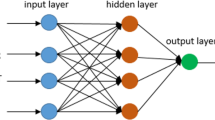Abstract
Over the last several years, various clustering algorithms for wireless sensor networks have been proposed to prolong network lifetime. Most clustering algorithms provide an equal cluster size using node’s ID, degree and etc. However, many of these algorithms heuristically determine the cluster size, even though the cluster size significantly affects the energy consumption of the entire network. In this paper, we present a theoretical model and propose a simple clustering algorithm called Location-based Unequal Clustering Algorithm (LUCA), where each cluster has a different cluster size based on its location information which is the distance between a cluster head and a sink. In LUCA, in order to minimize the energy consumption of entire network, a cluster has a larger cluster size as increasing distance from the sink. Simulation results show that LUCA achieves better performance than conventional equal clustering algorithm for energy efficiency.
Similar content being viewed by others
References
Ai, J., Turgut, D., & Boloni, L. (2005). A cluster-based energy balancing scheme in heterogeneous wireless sensor networks. In Proceedings of the 4th international conference on networking (ICN). April, 2005.
Amis, A. D., Prakash, R., Vuong, T. H. P., & Huynh, D. (2000). Max–min d-cluster formation in wireless ad hoc networks. In Proceedings of INFOCOM. March, 2000.
Akyildiz I. F., Su W., Sankarasubramnian Y., Cayirci E. (2002) A survey on sensor networks. IEEE Communications Magazine 40: 102–114
Baker D. J., Ephremides A. (1981) The architectural organization of a mobile radio network via a distributed algorithm. IEEE Transactions on Communications 29(11): 1694–1701
Bandyopadhyay, S., & Coyle, E. J. (2003). An energy efficient hierarchical clustering algorithm for wireless sensor networks. In Proceedings of IEEE INFOCOM. April, 2003.
Bettstetter, C. (2004). The cluster density of a distributed clustering algorithm in ad hoc networks. In Proceedings of IEEE, ICC. June, 2004.
Buettner, M., Yee, G. V., Anderson, E., & Han, R. (2006). X-MAC: A short preamble MAC protocol for duty-cycled wireless sensor networks. In Proceedings of ACM SenSys. November, 2006.
Cao, Y., He, C., & Wang, J. (2005). A backoff-based energy efficient clustering algorithm for wireless sensor networks. In Lecture notes in computer science (LNCS) (Vol. 3794). Berlin, Heidelberg: Springer.
Chan, H., & Perrig, A. (2004). ACE: An emergent algorithm for highly uniform cluster formation. In Proceedings of the first European workshop on sensor networks (EWSN). January 2004.
Culler D., Estrin D., Srivastava M. (2004) Overview of sensor networks. IEEE Computer 37(8): 41–49
Ephremides, A., Wieselthier, J. E., & Baker, D. J. (1987). A design concept for reliable mobile radio networks with frequency hopping signaling. In Proceedings of IEEE (no. 1, Vol. 75, pp. 56–73).
Heinzelman, W. R., Chandrakasan, A., & Balakrishnan, H. (2000). Energy-efficient communication protocol for wireless microsensor networks. In Proceedings of 33rd annual Hawaii international conference on system sciences (HICSS ’00) (Vol. 2, pp. 3005–3014). January, 2000.
Johnson, D. B., & Maltz, D. A. (1996). Dynamic source routing in ad hoc wireless networks. In Mobile computing (Vol. 353, pp. 153–181). New York: Kluwer.
Lee, H. Y., Seah, W. K. G., & Sun, P. (2006). Energy implications of clustering in heterogeneous wireless sensor networks—An analytical view. In IEEE international symposium on personal, indoor and mobile radio communications (PIMRC). September, 2006.
Li, C., Ye, M., Chen, G., & Wu, J. (2005). An energy-efficient unequal clustering mechanism for wireless sensor networks. In Proceedings of the 2nd IEEE international conference on mobile ad-hoc and sensor systems (MASS’05). November 2005.
Lin C. R., Gerla M. (1997) Adaptive clustering for mobile wireless networks. IEEE Journal of Selected Areas in Communications (JSAC) 15(7): 1265–1275
Ma M., Yang Y. (2007) Adaptive triangular deployment algorithm for unattended mobile sensor networks. IEEE Transactions on Computers 56: 946–947
Manjeshwar, A., & Agrawal, D. (2001). TEEN: A routing protocol for enhanced efficiency in wireless sensor networks. In Proceedings of 15th international parallel and distributed processing symposium (pp. 2009–2015). April, 2001.
Park, B., Lee, S., Song, Y., & Kim, C. (2004). Energy-efficient optimal clustering size for wireless sensor networks. In 31th Korea information science society (KISS) fall conference. October, 2004.
Perkins, C. E., & Royer, E. M. (1999). Ad hoc on-demand distance vector routing. In Proceedings of the 2nd IEEE workshop on mobile computing systems and applications, February, 1999.
Qin, M., & Zimmermann, R. (2005). An energy-efficient voting-based clustering algorithm for sensor networks. In Proceedings of ACIS international workshop self-assembling wireless networks (SAWN). May, 2005.
Shu, T., Krunz, M., & Vrudhula, S. (2005). Power balanced coverage-time optimization for clustered wireless sensor networks. In Proceedings of ACM MobiHoc’05 (pp. 111–120). May 2005.
Soro, S., & Heinzelman, W. (2005). Prolonging the Lifetime of Wireless Sensor Networks via Unequal Clustering. In Proceedings of 5th international workshop on algorithms for wireless, mobile, ad hoc and sensor networks (WMAN ’05). April, 2005.
Tian, Q., & Coyle, E. J. (2006). Optimal distributed detection in clustered wireless sensor networks: The weighted median. In Proceedings of IEEE INFOCOM 2006. April, 2006.
Wen C. Y., Sethares W. A. (2005) Automatic decentralized clustering for wireless sensor networks. EURASIP Journal on Wireless Communications and Networking 5(5): 686–697
Wen, C. Y., & Sethares, W. A. (2006). Adaptive decentralized re-clustering for wireless sensor networks. In Proceedings of IEEE international conference on systems, man, and cybernetics. October, 2006.
Ye, W., Heidenmann, J., & Estrin, D. (2002). An energy-efficient MAC protocol for wireless sensor networks. In Proceedings of IEEE INFOCOM. June, 2002.
Author information
Authors and Affiliations
Corresponding author
Rights and permissions
About this article
Cite this article
Lee, S., Choe, H., Park, B. et al. LUCA: An Energy-efficient Unequal Clustering Algorithm Using Location Information for Wireless Sensor Networks. Wireless Pers Commun 56, 715–731 (2011). https://doi.org/10.1007/s11277-009-9842-9
Published:
Issue Date:
DOI: https://doi.org/10.1007/s11277-009-9842-9




